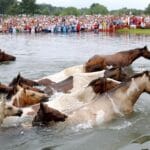Imagine a lonely coral atoll, adrift in the vast expanse of the Pacific Ocean, its emerald-green canopy whispering tales of survival and mystery. This is Nikumaroro, once known as Gardner Island, a place where time seems to stand still, yet the echoes of history resonate with unyielding intrigue. This remote outpost, part of the Republic of Kiribati, holds the key to unraveling one of history’s most captivating enigmas – the disappearance of Amelia Earhart.
A Paradise Shrouded in Mystery
Nikumaroro, an elongated, triangular atoll, measures a mere 7.5 km (4.7 mi) long by 2.5 km (1.6 mi) wide. Lush vegetation, dominated by towering Pisonia trees, forms a dense canopy that conceals the island’s secrets. Beneath this verdant exterior lies a challenging environment, where freshwater is scarce and survival hinges on a delicate balance with nature.
The island, known by a string of names in the early 19th century, was officially christened Gardner Island in 1840 by the USS Vincennes of the U.S. Exploring Expedition. However, its I-Kiribati heritage runs deep, reflected in its current name, Nikumaroro, derived from the legendary goddess Nei Manganibuka. According to Gilbertese tradition:
“The current name for the Island, Nikumaroro, comes from the name of a legendary goddess of the Gilbertese people, “Nei Manganibuka”. It is said that she comes from Samoa, is associated with the Buka tree, and is considered to be an important ancestor to many Gilbertese clans who originated on the island of Beru.”
While the goddess’s story speaks of ancient ties to the island, attempts at permanent human settlement have been met with challenges. A colonization effort in the early 20th century faltered, and even the relocation of I-Kiribati people to Nikumaroro in 1939 proved unsustainable due to the scarcity of reliable freshwater sources. Today, the island remains uninhabited, its silence broken only by the cries of seabirds and the ceaseless rhythm of the waves.
The Amelia Earhart Enigma: Did Nikumaroro Witness Her Final Landing?
The year was 1937. Amelia Earhart, a pioneering aviator attempting a daring circumnavigation of the globe, vanished without a trace over the Pacific Ocean. Her disappearance sparked one of the greatest aviation mysteries of all time, a puzzle that continues to captivate imaginations to this day. Among the many theories proposed, one stands out – the possibility that Earhart made an emergency landing on then-uninhabited Gardner Island, now Nikumaroro.
The evidence, while circumstantial, is compelling. Aerial photographs taken in 1940, just months after Earhart’s disappearance, revealed intriguing anomalies on Nikumaroro – what appeared to be an aircraft landing gear and a makeshift campsite. Subsequent expeditions by organizations like TIGHAR (The International Group for Historic Aircraft Recovery) unearthed artifacts that further fueled speculation: fragments of a woman’s shoe, a makeup compact, and tools that some believe could have belonged to Earhart or her navigator, Fred Noonan.
Perhaps the most tantalizing clue surfaced in 1940 when a collection of human bones, a female shoe, and a sextant box were discovered near the remnants of a campfire on Nikumaroro. The initial analysis of the bones suggested a possible match with Earhart’s physical characteristics, but tragically, the skeletal remains were subsequently lost, making conclusive identification impossible.
Nikumaroro Today: A Sanctuary for Wildlife, a Beacon for Discovery
Though permanently uninhabited, Nikumaroro has become a haven for wildlife and a site of immense ecological significance. As part of the Phoenix Island Protected Area, the island’s pristine ecosystem provides a sanctuary for a diverse array of species, from coconut crabs and migratory birds to a rich variety of marine life.
For scientists and researchers, Nikumaroro represents a unique opportunity to study a relatively untouched environment. Ongoing efforts to unlock the secrets of Amelia Earhart’s disappearance continue to employ increasingly sophisticated techniques, from forensic analysis of recovered artifacts to the use of ground-penetrating radar in the search for the lost Electra aircraft.
Nikumaroro, with its dense forests, hidden lagoons, and whispers of the past, remains an enigma. It is a place where the boundaries between history and mystery blur, where the pursuit of answers often leads to more questions. Will we ever know with certainty whether this remote atoll witnessed Amelia Earhart’s final landing? Perhaps, with time and continued exploration, Nikumaroro will finally relinquish its hold on this enduring mystery. Until then, it will remain a captivating testament to the enduring power of the unknown.
- Jesus Bible: Discover Jesus’s Story Throughout Scripture - April 27, 2025
- Don Luis: Unraveling the 16th-Century Virginia Mystery - April 27, 2025
- Captain J’s Kauai Tours: Unforgettable Na Pali Coast Adventures - April 27, 2025
















